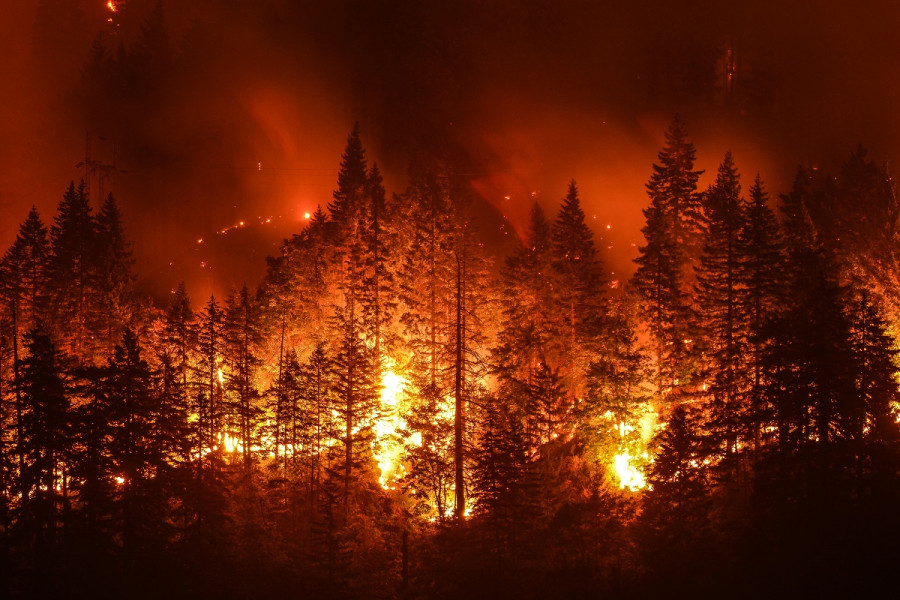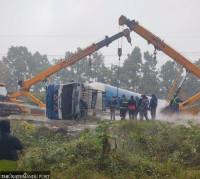National
Forest fire incidents down across the country during Covid-19 pandemic, study finds
Nearly 90 percent of wildfires are human-induced and with people staying indoors due to the lockdown, it is good news for the environment.
Chandan Kumar Mandal
The Covid-19 pandemic has come as a blessing for the country’s green cover.
A study published in World Development journal has found that incidents of forest fire went down considerably this year saving hundreds of hectares of forest from burning down to ashes.
Nearly 5 percent decrease in forest fire incidents was reported between December and April which could be attributed in part to the restricted public movement, according to the study authored by Jayash Paudel, an environmental economist.
“Reduction in forest fire incidents is an unintended positive spillover impact of Covid-19 pandemic,” Paudel, who is currently a professor of economics at Boise State University in the United State of America, told the Post over the phone. “While the pandemic has caused a massive effect—both short-term and long-term repercussions on the economy, health and labour market—it has left a short-term positive impact on the environment sector for a country which loses significant area of forest cover every year.”
The researcher had relied on satellite data available on the Fire Information for Resource Management System for real-time active fire locations from December 4, 2019 to April 9, 2020. Based on real-time fire incidents, the researcher measured the brightness of the forest fire to its severity, the energy released from the fire for knowing intensity and the number of forest fire events or the number of wildfire incidents.
It is estimated Nepal has been losing around 200,000 hectares of forest cover every year since 2005 to forest fires. Most of these fire incidents are human-induced and occur during the dry season, mostly between March and May.
Findings of the study indicated that with every additional reported case of Covid-19 resulted in a decrease of 1.94 Kelvins (K) in the brightness of forest fires, an 11.36 percent decrease in the fire radiative power associated with forest fires resulting in a total of 4.54 percent decrease in the number of forest fire incidents.
“It is a well-documented fact that nearly 90 percent of wildfires are caused by human activities in Nepal and when people were out of the forest and remained indoors during the lockdown phase, it naturally brought down the incidents of forest fires,” said Paudel.
“The positive impact of lockdown in the form of lesser wildfire incidents were even stronger in districts where public movements were strictly implemented. Other than the absence of humans in the forests, high pre-monsoon rainfall this spring may have dampened the number of fires as well.”
Effect of the lockdown on the reduction of forest fires was more pronounced in districts with smaller areas of community-managed forest per capita, with 8.11 percent drop in the number of wildfire incidents in such districts and in districts of the Bagmati Province, reported the study.
There is also evidence of the short-term impact of the Covid-19 on different measures of environmental quality like on emissions, the natural environment and trade of wildlife, among others.
Air quality has improved in the world’s major cities, including Kathmandu after a drop in pollutant emission from transport and industrial sectors. Likewise, energy consumption has reduced and the surface water quality has improved during the Covid-19 lockdown.
According to a study, lockdown measures have also contributed to a reduction in forest fire incidents in two Indian mountain states of Uttarakhand and Himachal Pradesh during the lockdown.
For developing countries like Nepal, annual forest fire has been a major threat to the loss of hundreds of thousands of hectares of green cover, biodiversity, human lives and property.
Most of these fires have been linked with deliberate burning while making land for farming, while collecting non-timber forest products, due to human negligence and accidents causing massive forest degradation and damage of physical infrastructure affecting livelihoods of people, according to Paudel.
“Estimates suggest that forest fires result in an annual economic loss of Rs5,000 per household, equivalent to 7.32 percent of the annual gross domestic product per capita in Nepal,” said Paudel.
According to him, a rough calculation suggested that Covid-19 induced reduction in the number of forest fire incidents resulted in an economic gain of Rs360 per household.
The potential economic gain from reduced forest fires is crucial for Nepal, said the study, as it could translate into a decrease in damage of physical infrastructure, an increase in air quality and availability of forest resources among local people for their livelihoods.
“This does not mean that the global pandemic, in general, is beneficial for us. It has devastating impacts across several sectors,” said Paudel. “Instead, this study points out that environmental benefits from reduced incidences of forest fires and improved air quality during the lockdown may partially offset the socioeconomic cost of pandemics across different parts of the globe.”




 17.12°C Kathmandu
17.12°C Kathmandu













%20(1).jpg&w=300&height=200)

